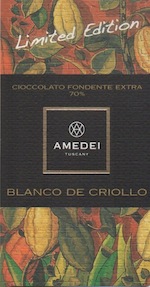(Excerpt from Amedei’s Blanco de Criollo bar review & a sequel to Chocolate Awards: Feast or Famine… or Fraud? Part I)
As the British Empire continues its retreat to the “emerald isle” as Shakespeare put it, England itself has paradoxically become cosmopolitan rather than provincial because of it. The empire coming home to roost in the best sense. That it straddles the North Atlantic with one foot leaning toward Europe & the other America translates into a side porch view of history which sometimes visits its own doorstep.
A couple chocolate awards shows emanating from there reflect this split stance.
And likewise their respective gold medal winners – one show awarded Pacari’s 70% Cacao Raw & another crowned this Blanco de Criollo by Amedei — divide the 2 distinct camps of chocolate flavor profiles & styles.
Since neither of these entered the competitive field of the other (professional courtesy?), somebody had to break the tie & who better than the C-spot®?
And the winner is…
By contrast, in this opening divide that separates barsmiths who approach their craft with a philosophy in mind, it is the experimental school called retro-American (a term coined by the C-spot® as it applies to chocolate) that nowadays applies a light touch to let cacáo’s notes ring at their natural pitch.
Where Euros über-refine cacáo to the point that some feel it tastes sanitized if not sterilized, the retro-Americans keep it closer to its original state which, frankly, can sometimes be harsh, & other times something to absolutely savor.
Bold, up-front, & occasionally over-the-top. Less idealized, more pragmatic / down-to-Earth. The difference between experimental vs. traditional; between risk-filled, bebop & free vs. calculated & tried ‘n true.
Clean / lean ‘n mean due in some measure to a higher than average cacáo-mass, at percentages that embody greater indigenous chocolate. Spare in their formulations too; increasingly containing only cocoa mass catalyzed by minimal-to-modest sugar, without any other additives (neither vanilla, nor lecithin, nor additional cocoa butter). Slightly underdone / underdeveloped, though by no means unrefined – a house preference (imagine lower-impact processing without Domori’s ultra-finesse) – that lets cacáo do most of the jawing for itself. Sums up to ‘addition by subtraction’. In a word, ‘transparent’.
Often realized thru a light low ‘n slow roast in the tradition of American pioneer Scharffen Berger (or even no roast at all in the case of “raw chocolate”). Plus granite-grinding that leaves no stone unturned in the chocolate; indeed, it leaves some behind in it (often more than a mere ghost trace). Or ball mills that abrade off small bits of oxidative metal. Followed by a conche that partially or even barely coats the particles (almost Mesoamerican… before the conche invention). A gentle tact for compound preservation that retains some volatiles in the flavor bank.
All of it creating semi-wild signatures to re-conceptualize chocolate. The subject being the bean itself rather than some confected artifice of it.
Bars like Ujuxtes 70 by Danta, or Amano’s Montanya, Askinoisie’s Davao &, in a more radical vein, every issue from Taza, partially bear the fruits of this style.
Which represents the “true chocolate”? Classic Euro or retro-Am? Neither, for chocolate, ever malleable, by its very physics is whatever one makes of it. But if referring to the closest thing to chocolate’s inventors in the ancient Americas, then in some respects both can stake a claim to being the “true” heirs.
By striving for smoothness, the Classical European mirrors the Mayan gastronomers who naturally selected prized cultivars for hi-flavor, bringing forth arguably the finest cacáo ever cultivated on Earth where chocolate culture itself reached its zenith – in Mesoamerica.
Over the centuries – millennia really – the Maya developed & refined chocolate craft. They planted for variety & diversity on a stunning scale – even by modern standards. Each selection based on desirable traits & described by respective fruit colors: (ix sac [white], ix kan [yellow], ix chak [red], ix morado [purple], & even ix box [black]).
The apex of their innovations was of course their gift to posterity – the supremely supple Criollo, an ancient classic varietal that experienced the highest degree of cultivation in pre-Columbian times. In the making for over 1,500 years with a gastronomy so fine it could be relished, according to Fray Bartolomé de Fuensalida in 1618, without any additives whatsoever (sugar, vanilla, chili, etc.).
retro-American equally identifies with chocolate’s inventors. Modern technical engineering incorporates ancient processing methods deep within its machinery — as well as some new ones — that elaborate upon the original chocolate manufacturing. In pursuing an artisanal track with vintage equipment & light gentle treatments that walk back some from over-processing, retro-American mimics the manual production of early Americans whose chocolate making involved barro comals (clay cookware), metate & mano stones (a type of mortar & pestle / rolling pin), elbow grease & sweat. Its sensibilities are rooted in homegrown / handcrafted goods, extending so far as to build personal relations in a direct trade network with Bromans / planters in the tropics where cacáo only grows.
Classical European or retro-American, each has its plusses & minuses, advantages & deficiencies, fans & foes. Look at them as different cuts of the diamond. Some polished; some hewn. Either way, whether a jewel or in-the-rough, they’re both gems.
So which of these 2 particular gold-medal bars bests the other? The tie-breaking vote is reflected in their respective ratings (for Pacari’s rating see its full review).
Since these respective winners played in restricted fields (confined to those vendors who can afford the entry fees & are willing to pay them), it prompts a lingering question: which is the best bar on Earth circa 2012 / 2013 in an unrestricted wide open field?
The Chocolate Census houses no such constraints. It goes out of its way to count everyone in the known premium chocolate universe.
Among this much broader population, the best bar of the year goes to Patric’s Signature Blend.





